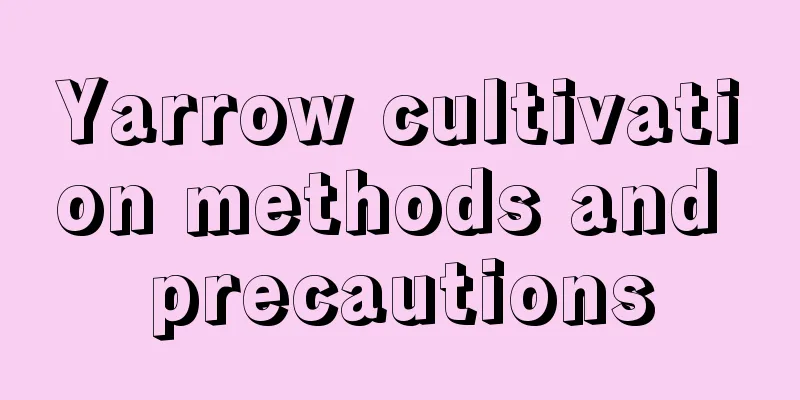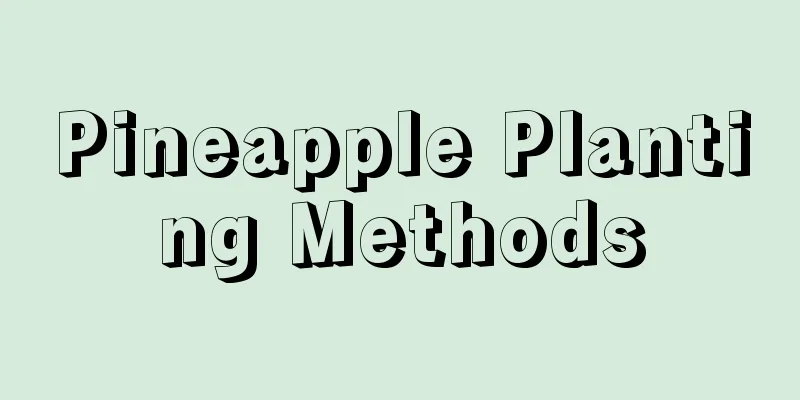Yarrow cultivation methods and precautions

1. Maintenance methods1. Temperature: The best environment for yarrow is 5-25℃. It is relatively cold-resistant, but the temperature cannot be too high. 2. Light: Sufficient light must be ensured during breeding, and it must not be exposed to direct strong light, especially when the temperature is relatively high in summer. If you don't pay attention to protecting it, the leaves will definitely turn yellow. 3. Soil: Its requirements for soil are not particularly high. Generally, it can be grown in slightly moist soil and sandy loam. 4. Water: The moisture in the soil should be moderate. If there is too much moisture, drain it in time; if there is too little moisture, water it in time. Do not water too much to avoid root rot. When there is a lot of water accumulation in the pot, the roots will rot, and the leaves will turn yellow, so it is necessary to drain the water in time. 2. Breeding techniques1. Overwintering: The breeding temperature in winter cannot be lower than 5℃. When there is sunshine, appropriate light supplement should be provided. The soil cannot be too dry. When watering, do not water too much at one time, but water moderately. 2. Summer: It rains frequently and the temperature is high in summer. At this time, we must not allow a large amount of water to accumulate in the flower pots. At the same time, make sure the plants are not exposed to direct sunlight. 3. Problem diagnosis and treatment1. Root rot: Many plants will suffer from root rot. This happens mostly because there is too much water in the pot. At this time, you need to take good care of the plants and do a good job of drainage in time. 2. Yellow leaves: This may be caused by excessive light, or by lack of water or excessive water. Once you know the problem, you should deal with it in time and solve it. If you take good care of it, it will naturally thrive. IV. Other issues1. Is it poisonous? It is not poisonous, so don’t worry too much and you can safely maintain and appreciate it. 2. Whether to grow it at home: Yarrow can be grown at home to keep the home fresh enough and provide it with more sunlight. |
<<: Cultivation methods and precautions of black persimmon
>>: Amaranth cultivation methods and precautions
Recommend
Growing environment conditions and characteristics of Polygonum multiflorum
Growing environment conditions and requirements o...
How to water jasmine
1. Spring In spring, jasmine needs to resume grow...
What is straw?
What kind of crop is straw? Straw generally refer...
How to grow lisianthus potted plants
1. Temperature Lisianthus has a very low resistan...
How to grow Agapanthus
1. Soil During breeding, the soil should have goo...
How many years can cyclamen live and how long can it bloom?
1. How many years can cyclamen live? Cyclamen is ...
Green radish planting method and time cultivation method and steps
The best time to plant radish The planting time o...
How many years does it take for Jade Tree to bloom (Flowering conditions and maintenance methods of Jade Tree potted plants)
How to care for jade tree so that it can bloom If...
Can cherries be grown in Henan?
Can cherries be grown in Henan? Cherries can be g...
Can anthuriums be placed in the bedroom? What plants can be placed in the bedroom?
1. Can I put it? It is a plant with a very beauti...
How to water and plant potted kapok
1. How to water potted kapok Kapok plants are nat...
When is the right time to prune computer baby?
Computer baby pruning function Computer baby is a...
How to prune pine trees? Pruning methods and time
Pine tree pruning time The best time to prune pin...
Is it profitable to plant Paris polyphylla? What are the profits and prospects of planting Paris polyphylla?
Is planting Paris polyphylla profitable? Planting...
The advantages and disadvantages of pink snow mountain roses The advantages and disadvantages of pink snow mountain series roses
Pink Snow Mountain Rose belongs to the Rosaceae f...









